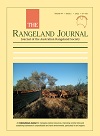
The Rangeland Journal
Volume 44 Number 2 2022
This paper contributes to our understanding of how grazing disturbances influence ground dwelling-spider assemblages. Research on short-duration kraaling has grown rapidly in recent decades, with a focus on grass quality, diversity and functional composition on macro-invertebrates, with limited work on spider assemblages. This work leads the way to identifying ‘indicator taxa’ in terms of arthropod functional groups for populations and distributions at different scales over time and space. These may then be used to assess and predict pasture health. The results of this work also provide valuable data and analyses that will most likely contribute to informing future land-use reformation policies.
RJ22004 Abstract | RJ22004 Full Text | RJ22004PDF (2.6 MB) Open Access Article
RJ21062Some soil factors constraining buffel grass (Cenchrus ciliaris L.) seedling growth rate across a range of acid red Kandosols in Queensland, Australia
Buffel grass is loved by pastoralists and hated by many conservationists. The soil chemical factors other than phosphorus that restrict its seedling growth on red earths of southwest Queensland were investigated and pH-mediated aluminium toxicity was found to seriously control buffel seedling growth. When aiming to encourage or discourage its spread in particular areas, low pH of some soils may mediate complex nutrient interactions that further constrain buffel grass establishment other than the well-known phosphorus limitation.
RJ21056Diet quality, liveweight change and responses to N supplements by cattle grazing Astrebla spp. (Mitchell grass) pastures in the semi-arid tropics in north-western Queensland, Australia
In seasonally dry tropical rangelands, the amount and nutritional value of pasture fluctuates widely with rainfall and seasons. Experiments during 4 years examined the diet selected, cattle growth, and the effects of protein supplementation, on tropically adapted steers grazing Mitchell grass pastures in north-western Queensland, Australia. During the rainy season, diet quality and cattle growth were high, but declined progressively to weight loss in the late dry season. Cattle benefited from the protein supplements during the late dry season.
RJ21056 Abstract | RJ21056 Full Text | RJ21056PDF (958 KB) Open Access Article
RJ21057Opportunities to build resilience of beef cattle properties in the mulga lands of south-western Queensland, Australia
The major challenges facing beef producers in the mulga lands are the inherently low productivity and profitability of the region, exacerbated by widespread degradation, and climate and market variability. The farm-management economics framework was used to assess options to improve profitability and viability of a hypothetical beef cattle property in southwest Queensland, Australia. There was very limited potential to improve profitability or resilience of existing beef enterprises. However, full, or partial conversion to rangeland goat production or carbon farming, respectively, improved property returns and viability.
RJ21057 Abstract | RJ21057 Full Text | RJ21057PDF (879 KB) Open Access Article




